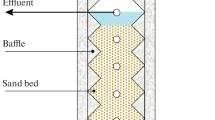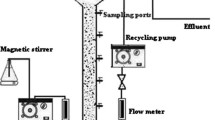Abstract
Phenol degradation was studied in two different agitation systems in a batc h reactor (mechanical agitation and orbital agitation) and the support of the most efficient system was used for fixed bed bioreactor studies. The support used was coconut shell charcoal. The results showed that the mechanical agitation bioreactor was more effective in phenol removal, due to the amount of biomass adhered to the support (8.56 mg gsupport−1), running at approximately 100% of the phenol biodegradation in 300 min. The toxicity analysis of the waters was moderate, because the EC50,48h values in the analyzed samples are higher than 50%. Within the experimental data obtained from the batch system, it was possible to find the parameters of the kinetic model of Michaelis-Menten, which was used to simulate the bioreactor in a fixed bed. A mathematical model of a one-equation, which considers the effects of dispersion, convection, and reaction in the liquid phase, and diffusion and reaction inside the biofilm was used and the results obtained through numerical simulation were compared with the experimental results of the bioreactor in a fixed bed, and new operational conditions in the bed were simulated with good accuracy.













Similar content being viewed by others
References
Agarry SE, Solomon BO (2008) Kinetics of batch microbial degradation of phenols by indigenous Pseudomonas fluorescence. Int J Environ Sci Technol 5:223–232
Al-Sheh S, Banat F, Abu-Aitah L (2003) Adsorption of phenol using different type of activated of bentonite. Sep Purif Technol 33:1–10
Anselmo AM, Cabral JMS, Novais JM (1989) The adsorption of Fusariom flocciferum spores on celite particles and their use in the degradation of phenol. Appl Microbiol Biotechnol 31:200–203
Associação Brasileira de Normas Técnicas (2016) NBR 12.713: Ecotoxicologia aquática – Toxicidade aguda - Método de ensaio com Daphnia spp. (Cladocera, Crustacea). Rio de Janeiro: ABNT
Bajaj M, Gallert C, Winter J (2009) Phenol degradation kinetics of an aerobic mixed culture. Biochem Eng J 46:205–209
Basak B, Bhunia B, Dutta S, Chakraborty S, Dey A (2013) Kinetics of phenol biodegradation at high concentration by a metabolically versatile isolated yeast Candida tropicalis PHB5. Environ Sci Pollut Res 21(2):1444–1454
Baskaran D, Rajamanickam R (2019) Aerobic biodegradation of trichloroethylene by consortium microorganism T from Turkey litter compost. J Environ Chem Eng 7:103260
Begum SS, Radha KV (2016) Comparative kinetic studies and performance evaluation of biofilm and biomass characteristics of Pseudomonas fluorescens in degrading synthetic phenolic effluent in inverse fluidized bed biofilm reactor. Water Environ Res 88:415–424
Bera S, Roy AS, Mohanty K (2017) Biodegradation of phenol by a native mixed bacterial culture isolated from crude oil contaminated site. Int Biodeterior Biodegradation 121:107–113
Bird RB, Stewart WE, Lightfoot EN (2004) Fenômenos de transporte, 2nd edn. LTC - Livros Técnicos e Científicos, Rio de Janeiro
Cai W, Li J, Zhang Z (2007) The characteristics and mechanisms of phenol biodegradation by Fusarium sp. J Hazard Mater 148:38–42
Carmona M, De Lucas A, Valverde JL, Velasco B, Rodríguez JF (2006) Combined adsorption and ion exchange equilibrium of phenol on Amberlite IRA-420. Chem Eng J 117:155–160
Coelhoso I, Boaventura R, Rodrigues A (1992) Biofilm reactors: an experimental and modeling study of wastewater denitrification in fluidized-bed reactors of activated carbon particles. Biotechnol Bioeng 40:625–633
Conama (2011) Conselho Nacional do Meio Ambiente, Resolução n° 430/2011. Brasília, Brasil
Consema (2017) (Conselho Estadual de Meio Ambiente), Resolução CONSEMA n. 355/2017. Porto Alegre, 2017. Disponível em: <http://www.sema.rs.gov.br/resolucoes>. Access in: jan. 2018
Costa C, Rodrigues A (1985) Part I Phenol adsorption on polymeric adsorbents. AIChEJ 31:1645–1654
Divya LM, Prasanth GK, Sadasivan C (2013) Isolation of a salt tolerant laccase secreting strain of Trichoderma sp. NFCCI-2745 and optimization of culture conditions and assessing its effectiveness in treating saline phenolic effluents. Int J Environ Sci 25:2410–2416
El-Naas M, Al-Zuhair S, Makhlouf S (2010) Continuous biodegradation of phenol in a spouted bed bioreactor (SBBR). Chem Eng J 160:565–570
Fan LS, Leyva-Ramos R, Wisecarver KD, Zehner BJ (1990) Diffusion of phenol through a biofilm grown on activated carbon particles in a draft-tube three-phase fluidized-bed bioreactor. Biotechnol Bioeng 35:279–286
Griem P, Snyder R, Bress B (2009) Acute exposure guidelines for selected airborne chemicals 7 ed. Washington, The National Academies Press
Guelli U, Souza SMA, Brandão HL, Ulson de Souza AA (2008) Modeling of liquid pollutant biodegradation process in a fluidized bed reactor with biofilm. Sep Purif Technol 60:162–173
Gupta VK, Ali I, Saini VK (2004) Removal of chlorophenols from wastewater using red mud: an aluminum industry. Waste Environ Sci Technol 38:4012–4018
Hasan SA, Jabeen S (2015) Degradation kinetics and pathway of phenol by Pseudomonas and Bacillus species. Biotechnol Biotec Eq 29:45–53
Hassard F, Biddle J, Cartmkella E, Stephenson T (2016) Mesh rotating reactors for biofilm pre-treatment of wastewaters – influence of media type on microbial activity, viability and performance. Process Saf Environ 103:69–75
Heipieper HJ, Keweloh H, Rehm H (1991) Influence of phenols on growth and membrane permeability of free and immobilized Escherichia coli. Appl Environ Microbiol 57:1213–1217
Hidalgo A, Jaureguibeitia A, Prieto MB, Rodríguez-Fernández C, Serra JL, Llama MJ (2002) Biological treatment of phenolic industrial wastewaters by Rhodococcus erythropolis UPV-1. Enzyme Microb Tech 31:221–226
Hsien TY, Lin YH (2005) Biodegradation of phenolic wastewater in a fixed biofilm reactor. Biochem Eng J 27:95–103
Hussain A, Dubey SK (2014) Specific methanogenic activity test for anaerobic treatment of phenolic wastewater. Desal Water Treat 52:7015–7025
International Organization for Standardization (2012) Water quality – determination of the inhibition of the mobility of Daphnia magna stratus (Cladocera, Crustacea) – acute toxicity test: ISO 6341. USA
Karapanagioti H (2016) Water management, treatment and environmental impact. HK, University of Patras, Patras, Greece. Encyclopedia of Food and Health
Kavitha V, Palanivelu K (2004) The role of ferrous ion in fenton and photophenton process for degradation of phenol. Chemosphere 55:1235–1243
Kim KT, Lee YG, Kim SD (2006) Combined toxicity of copper and phenol derivatives to Daphnia magna: effect of complexation reaction. Environ Int 32:487–492
Lazarova Z, Boyadzhieva S (2004) Treatment of phenol-containing aqueous solutions by membrane-based solvent extraction in coupled ultrafiltration modules. Chem Eng J 100:129–138
Lowry OH, Rosebrough NJ, Farr AL, Randall RJ (1951) Protein measurement with the Folin phenol reagent. Int J Biol Chem 193:265
Mahiuddin MD, Fakhruddin ANM, Abdullah AM (2012) Degradation of phenol via meta cleavage pathway by Pseudomonas fluoresces PU1. Int Scholarly Res Netw ISRN Microbiol 2012:1–6
Maliska CR (1955) Transferência de calor e mecânica dos fluidos computacional fundamentos e coordenadas generalizadas. LTC, Rio de Janeiro
Masteling RP, Castro BB, Antunes SC, Nunes B (2016) Whole-organism and biomarker endpoints in Daphnia magna show uncoupling of oxidative stress and endocrine disruption in phenolic derivatives. Ecotox Environ Safe 134:64–71
Mello JMM, Brandão HL, Ulson de Souza AA, Silva A, Souza SMAGU (2010) Biodegradation of BTEX compounds in a biofilm reactor Modeling and simulation. J Pet Sci Eng 70:131–139. https://doi.org/10.1016/j.petrol.2009.11.004
Mello JMM, Brandão HL, Valério A, Ulson de Souza AA, Silva A, Ulson de Souza SMAG (2019) Biodegradation of BTEX compounds from petrochemical wastewater: kinetic and toxicity. J Water Process Eng 32:100914. https://doi.org/10.1016/j.jwpe.2019
Monteiro AAMG, Boaventura RAR, Rodrigues AE (2000) Phenol biodegradation by Pseudomas putida DMS 548 in a batch reactor. Biochem Eng J 6:45–49
Özbelge T, Özbelge Ö, Baskaya S (2002) Removal of phenolic compounds from rubbertextile wastewaters by physicochemical methods. Chem Eng Process 41:719–730
Perron N, Welander U (2004) Degradation of phenol and cresols at low temperatures using a suspended-carrier biofilm process. Chemosfere 55:45–50
Rajani V (2015) Microbial degradation of phenol: a review. Int J Res 46:46–54
Reardon KF, Mosteller DC, Rogers JDB (2000) Biodegradation kinetics of benzene, toluene and phenol as single and mixed substrates for Pseudomas putida F1. Biotechnol Bioeng 69:385–400
Rice EB, Baird RB, Eaton AD (2005) Standard methods for the examination of water and wastewater, 21th edn. APHA/AWWA/ WEF, Washington
Rozich AF, Gaudy AF, D’Adamo PC (1985) Selection of growth rate model for activated sludges treating phenol. Water Res 19:481–490. https://doi.org/10.1016/0043-1354(85)90040-5
Sant’Anna GL Jr (2013) Tratamento biológico de efluentes: fundamentos e aplicações, 2a edn. Interciência, Rio de Janeiro
Santos VL, Linardi VR (2013) Biodegradation of phenol by a filamentous fungi isolated from industrial effluents – identification and degradation potential. Process Biochem 39(8):1001–1006
Scow K, Goyer M, Payne E, Perwak J, Thomas R, Wallace D, Wood M (2002) An exposure and risk assessment for phenol. USEPA – United States Environmental Protection Agency, Washington
Singh H (2006) Mycoremediation: fungal, bioremediation. edn. John Wiley and Sons
Sivasubramanian S, Namasivayam SKR (2015) Phenol degradation studies using microbial consortium isolated from environmental sources. J Environ Chem Eng 3:243–252
Thunga WE, Ong SA, Ho LN, Wong YS, Ridwan F, Lehl HK, Oon YL, Oon YS (2018) Biodegradation of Acid Orange 7 in a combined anaerobic-aerobic up-flow membrane-less microbial fuel cell: mechanism of biodegradation and electron transfer. Chem Eng 336:397–405
Van Schie PM, Young LY (2000) Biodegradation of phenol: mechanisms and applications. Bioremediat J 4:1–18
Villegas LGC, Mashhadi N, Chen M, Mukherjee D, Taylor KE, Biswas N (2016) A short review of techniques for phenol removal from wastewater. Curr Pollut Rep 2:157–167
Voice TC, Pak D, Zhao X, Shi J, Hichey RF (1992) Biological activated carbon in fluidized bed reactors for the treatment of groundwater contaminated with volatile aromatic hydrocarbons. Water Res 26(10):1389–1401
Wang SJ, Loh KC (1999) Modeling the role of metabolic intermediates in kinetics of phenol biodegradation. Enzyme Microb Technol 25:177–184
Wang Q, Li Y, Li J, Wang Y, Wang C, Wang P (2014) Experimental and kinetic study on the cometabolic biodegradation of phenol and 4-chlorophenol by psychrotrophic Pseudomonas putida LY1. Environ Sci Pollut Res 22(1):565–573
Whitaker S (1999) Theory and applications of transport in porous media: the method of volume averaging. Kluwer Academic, London
Wu J, Yin Y, Wang J (2018) Hydrogen-based membrane biofilm reactors fornitrate removal from water and wastewater. Int J Hydrogen Energ 43(1):1–15
Yang RD, Humphrey AE (1975) Dynamic and steady state studies of phenol biodegradation in pure and mixed cultures. Biotechnol Bioeng 17:1211–1235
Yemendzhiev H, Gerginova M, Krastanov A, Stoilova I, Alexieva Z (2008) Growth of Trametes versicolor on phenol. J Ind Microbiol Biotechnol 35(11):1309–1312. https://doi.org/10.1007/s10295-008-0412-z
Zagklisa DP, Vavourakia AI, Kornarosa ME, Paraskevat CA (2015) Purification of olive mill wastewater phenols through membrane filtration and resin adsorption/desorption. J Hazard Mater 285:69–76
Acknowledgments
The authors thank the research support foundation of the State of Rio Grande do Sul FAPERGS (grant no. 191/UFFS/2018).
Funding
This study was funded by the foundation of the State of Rio Grande do Sul FAPERGS (grant no. 191/UFFS/2018).
Author information
Authors and Affiliations
Corresponding author
Ethics declarations
Conflict of interest
The authors declare that they have no conflict of interest.
Additional information
Responsible editor: Ta Yeong Wu
Publisher’s note
Springer Nature remains neutral with regard to jurisdictional claims in published maps and institutional affiliations.
Rights and permissions
About this article
Cite this article
Ribeiro, H.B., Bampi, J., da Silva, T.C. et al. Study of phenol biodegradation in different agitation systems and fixed bed column: experimental, mathematical modeling, and numerical simulation. Environ Sci Pollut Res 27, 45250–45269 (2020). https://doi.org/10.1007/s11356-020-10380-4
Received:
Accepted:
Published:
Issue Date:
DOI: https://doi.org/10.1007/s11356-020-10380-4




